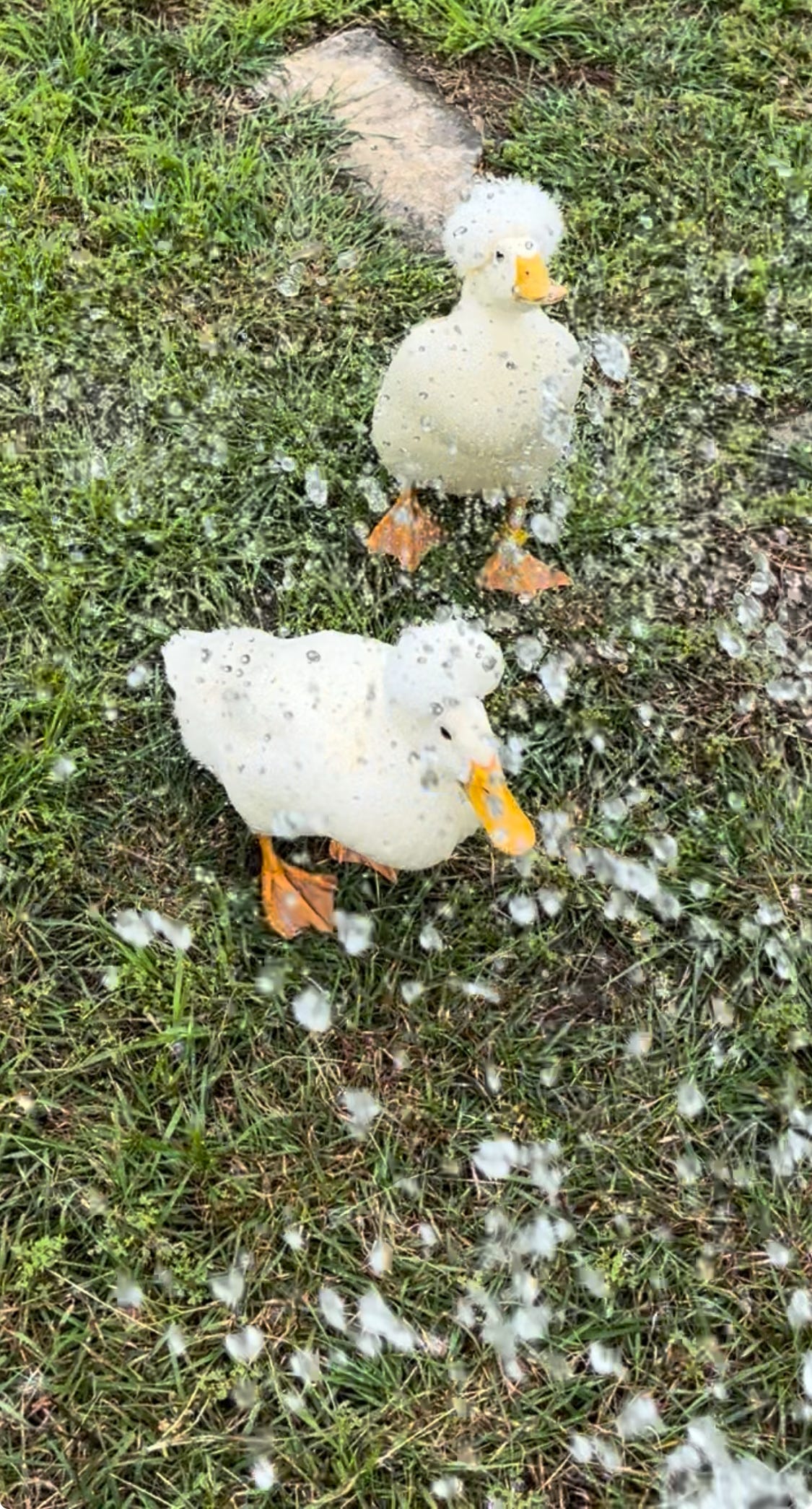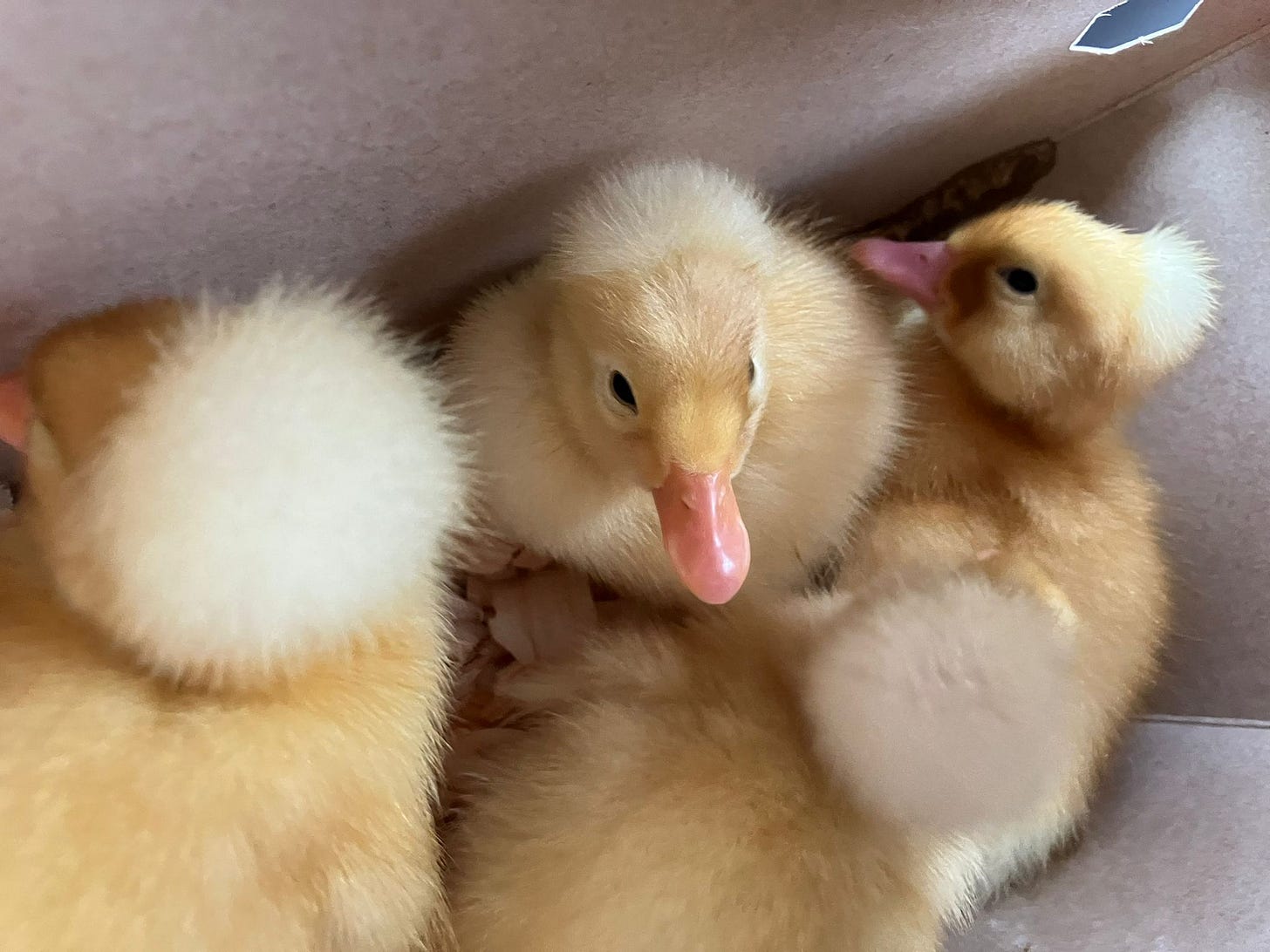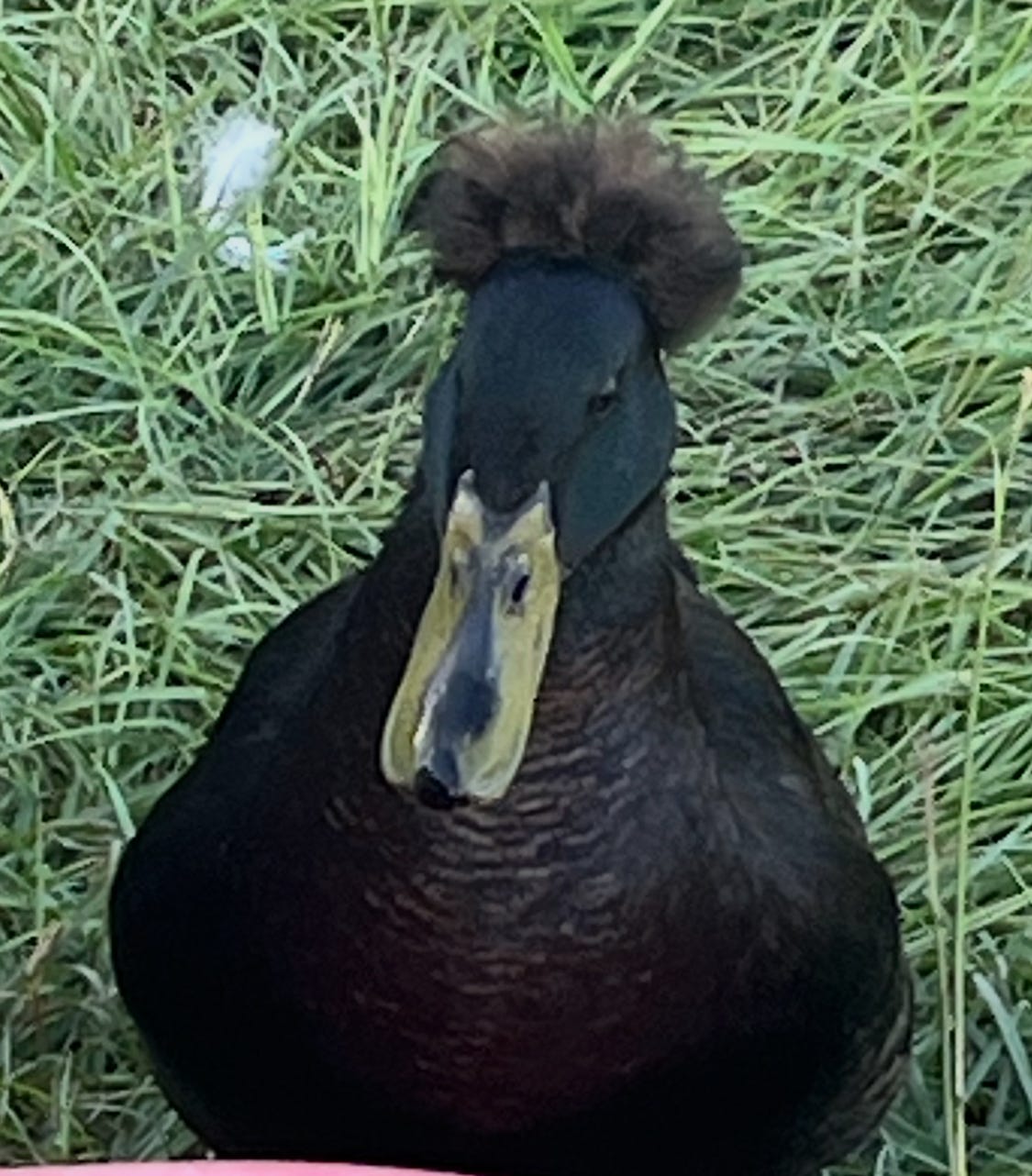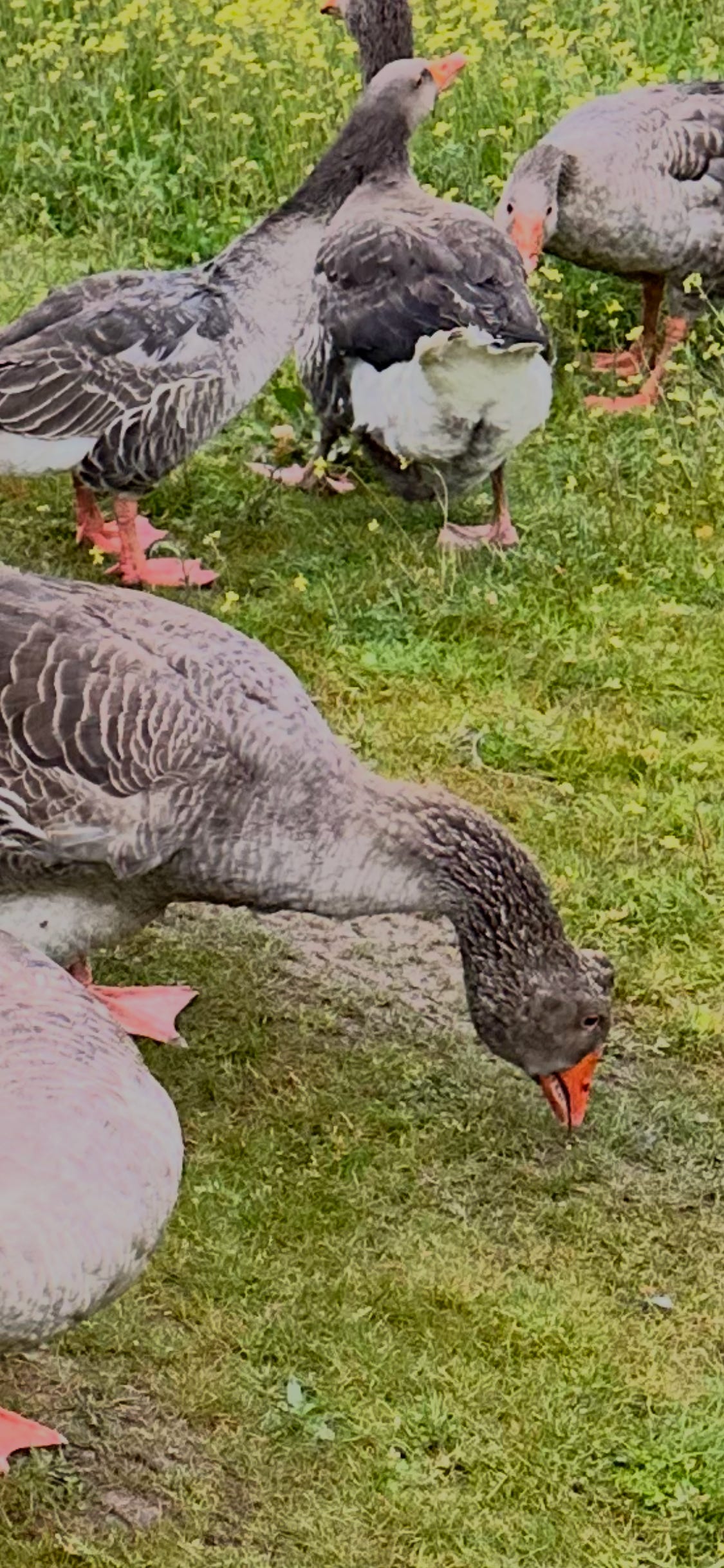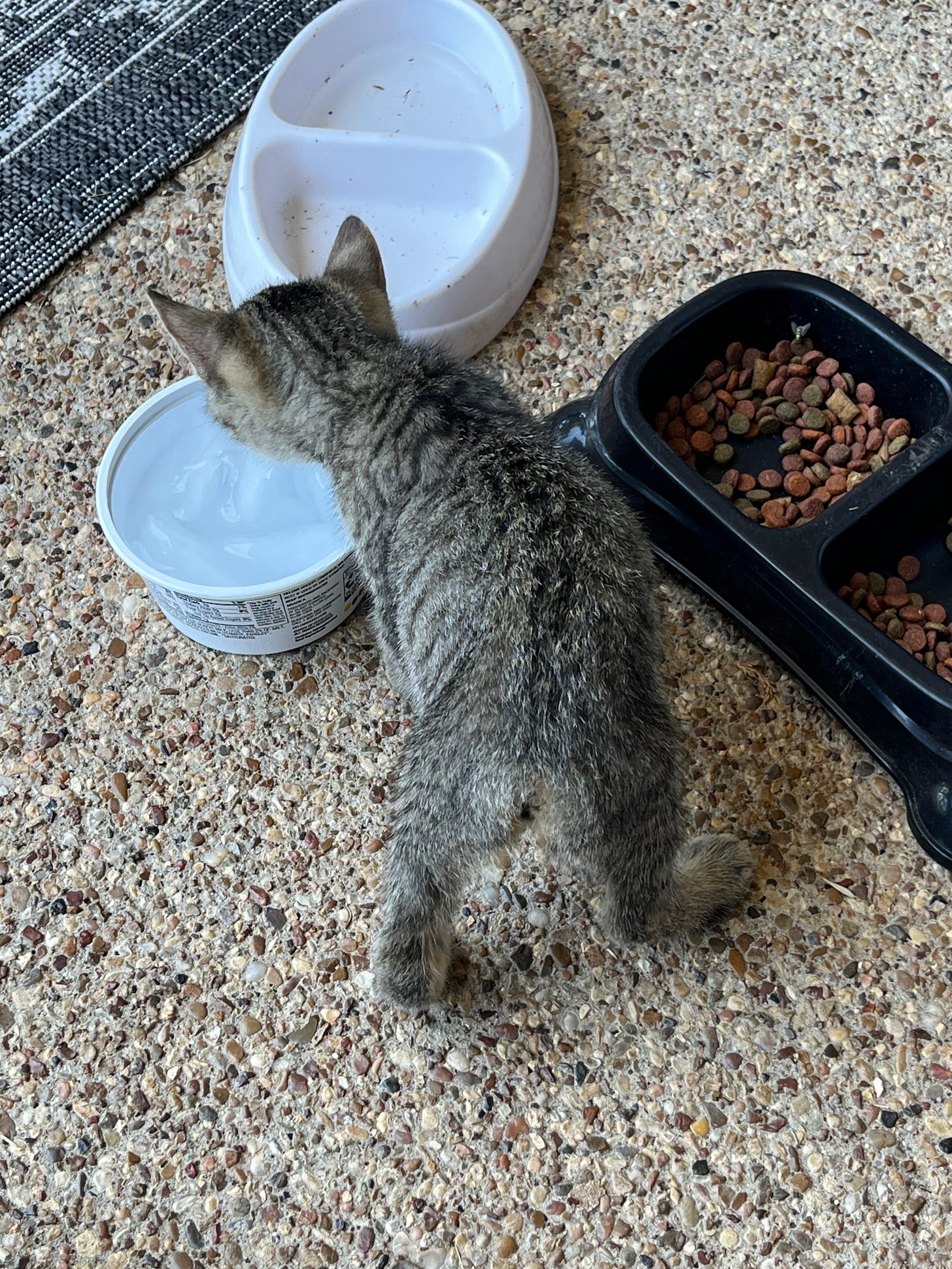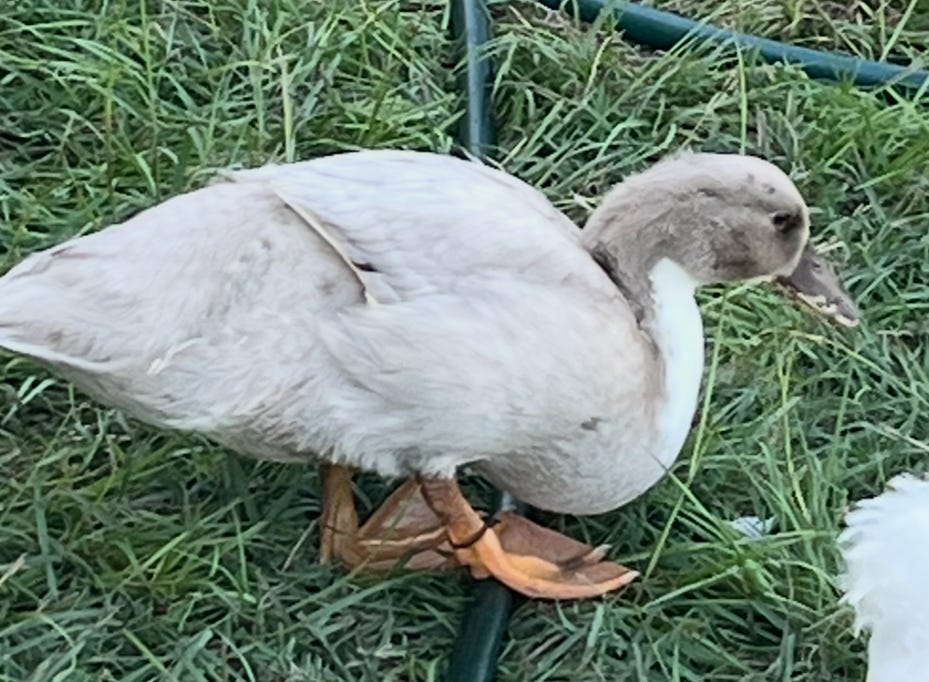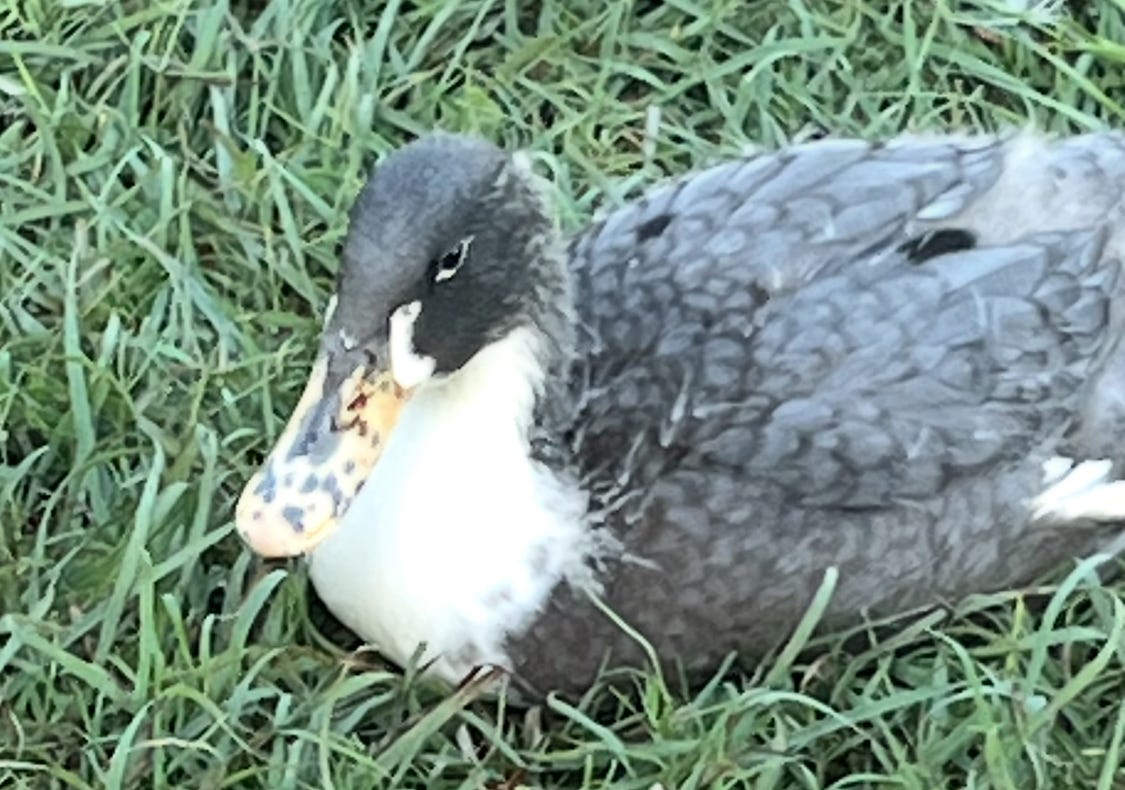Musings on Mutations
When the rare becomes the standard
Because of my love for and obsession with Crested ducks, I’ve come in contact with a lot of people that call me ‘unethical’ for ‘breeding mutations’. Despite sometimes discouraging me, having the opportunity to observe, study and be an engaged participant [treat dispenser] in my ducks’ lives lifts my spirits.
The commonly held belief on Crested ducks is that Dutch traders brought back Bali ducks (likely Crested Runner ducks) from the Indonesia area and bred them to heavier local ducks (similar to a Pekin). Since the 1700s, these unique-looking ducks have shown up in literature and art ever since. No wonder - of the duck breeds I’ve been able to own myself, they have the most character and least flightiness as well as an attractive poof on their head that varies in size and shape. A particular quirk I’ve noticed that they pass on to their offspring (along with just having the husbandry opportunity for it on my little ranch) is that they love to be sprayed with the hose. Not just a delicate sprinkle, they line up to be sprayed full in the face while catching water with bill chomps. They also have an uncanny sense of time, specifically the sprinkler schedule and along with slurping the water that collects around the sprinkler base, enjoy being sprayed inches from the nozzle. My other ducks (Cayuga, Buff and Saxony) enjoy the water but not quite that much and prefer swimming over spraying.
I have purchased 5 Cresteds from two different hatcheries, found a naturally occurring crest on a Cayuga on Craigslist and hatched over 20 ducklings from Crested breedings myself. I only had neurological issues show up in one. These were my first four Cresteds, purchased at a local Tractor Supply that is mainly supplied by Hoover’s Hatchery.
Nothing was out of the ordinary at first, but with a few weeks I started to wonder if this duckling was blind or nearly, and possibly deaf. It started to lag behind any time the others would run off in a pack and chirp incessantly until it sensed the others were close by again. Then it began developing a twitch in its neck that eventually caused its neck to curl under its body with bill pointed up. Even though with help it could eat, drink and swim like the others, I was concerned about its safety and wellbeing once they began to free range outside the barn. I didn’t want it to get stuck somewhere, get left behind or be picked off by a predator because of its issues. After a quick and humane euthanasia, I studied the crest and the skull carefully. There was a hole in the skull, about a quarter to half inch diameter and it appeared that the brain had been growing at a faster rate than the bone, which meant the edges of the hole were pressing on brain tissue. One duck amongst many is not a sample size, but it led me to a hypothesis that I would like to study further. I’m not willing to cull any ducks that are happy and healthy and haven’t lost any to predators (hopefully won’t, knock on wood!!) so it’s still a hypothesis: Does every Crested duck have a hole in its skull beyond the soft part every duck hatches with? Does the size of the hole have to do with homozygous genes for being crested and does the size affect the duck’s wellbeing? and the part I’m most excited to learn about: Does the hole in the duck’s skull close with time and age?
This last part I can observe externally with my recent hatches of Crested ducklings because as opposed to my other Cresteds, these duckies are colorful. As they grow, I can observe externally what color the crests are. If the crest feathers remain a duckling or juvenile color, it should support the theory that the hole closes with age. This difference should be most apparent in my male Mallard (Gray) pattern ducklings, which hatch stripey gray, develop into dark brown juvenile colors, then eventually their mature adult feathers with a green head and silver body. I still have a few months to observe my oldest Mallard guy, Borussia to see what color his crest eventually becomes.
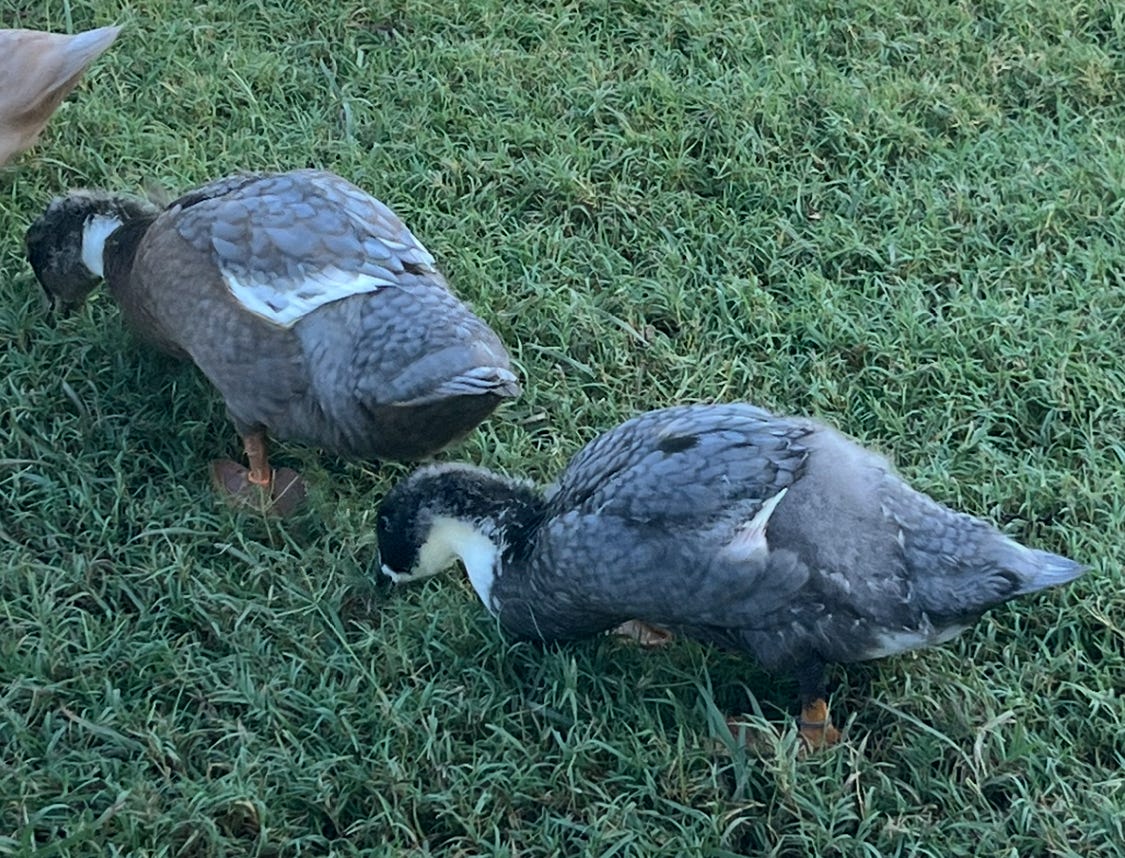
My other Crested babies also have duckling-colored poofs for now, but their mature head feathers won’t be so different as in the Mallard pattern.
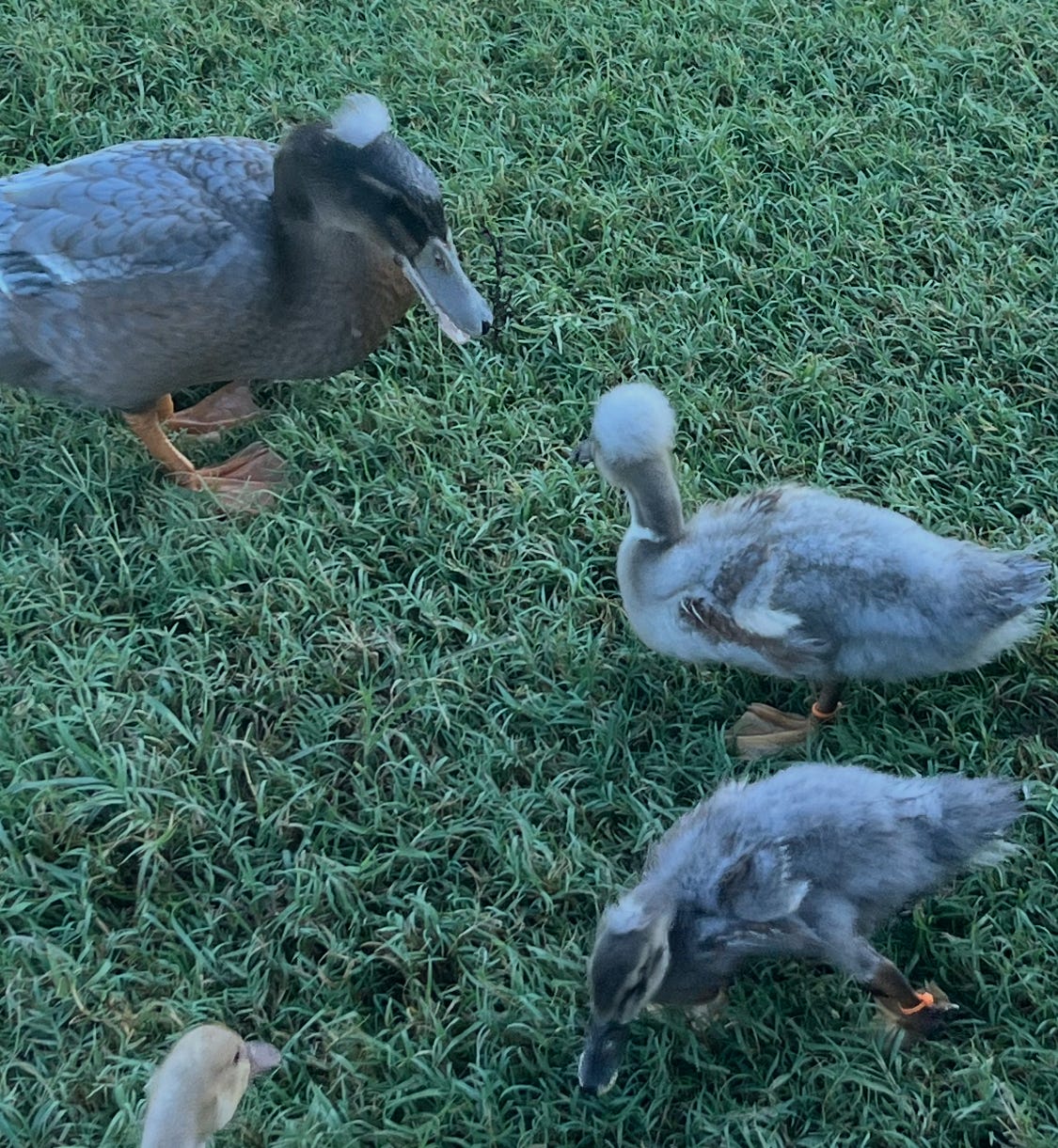
Like our Dutch traders, people for a long time have been selecting mutations as traits indicative of a breed standard. Mutations are what we call differences that happen at a genetic level that are sometimes expressed as a trait. All mallard-based ducks are capable of having a mutation that results in a visible crest, like Aurélien:
Muscovy ducks do not produce crests, or at least this is a commonly held assumption as I’ve never seen anyone attempt to rebuff that or study Moulard/Hinny ducks (mallard-muscovy hybrids) to see. Crested turkeys are possible, but so far it seems it is a skull defect that grows feathers and is never an inherited trait. On my trip to a wild goose farm in Europe, I discovered a crested goose, which I assume follows the same rules as ducks (either naturally occurring or inherited like Roman Tufted geese).
Even without databases and genetic sequencing, people hundreds of years ago figured out that selecting animals with a desired trait and breeding them to each other gave a good chance of that trait both being expressed and passed on, rinse and repeat for generations.
A non-duck example that I have experience with is our parking lot kitten we adopted, Isa. When I picked her up, I noticed she had no tail. While this can sometimes happen due to injury, she was perfectly healthy with no scarring so she was born this way. Having worked in the veterinary field with tailless cats that had incontinence or digestive issues, I was concerned. Observing her closely and having her checked out by my vet made me feel better since other than being young, small and likely the first time away from her mom, she is fine. She needed help learning to reliably use the litter box and keep herself clean. She also has an interesting gait, which my husband likens to a bunny hopping around since she uses both back legs at the same time unlike regular cats.
These cats are called Manx cats because many of them were intentionally bred without tails (trait selection) on the Isle of Man. Limiting genes to selected traits is much easier on an island than elsewhere because of a limited gene pool with progressively less diversity. An evolutionist would say traits that get selected and passed on are what make that specific animal successful. The Manx example could be explained as a limited set of genes because of being on an island, although there is manmade influence on the selection of those traits. The same could be argued about crested ducks - did the crests actually make them genetically more successful, or was their success attributed to a trait considered attractive to people who became invested in selecting for and passing on that trait?
I love to use Pug dogs as examples of trait selection by humans, since a small dog with eyes that easily pop out of their sockets prone to obesity really would not equal genetic success ‘in the wild’. However, these traits were attractive to humans that kept Pugs around and constantly selected for these traits through generations.
As my latest crested ducklings grow and mature, I’ve been able to observe and study things I might have missed or not been aware of. The July hatch especially has been important to my two discoveries after publishing my previous article on breeding Crested ducks:
Every mallard (Gray) colored male I hatched from this breeding has a crest. Originally I had marked one only from the June hatch as non crested, but as time went by I noticed a tiny, two feather crest on his head. I also have begun thinking that duckling Wrexham, who hatched a very light silvery gray I thought was female Buff Lilac Mallard - is actually a very dilute Mallard male. That would mean that the 7 Mallard pattern ducklings from combined hatches are all male and crested. Does the crest favor males or is it linked to the mallard coloring specifically? I will continue to ponder and document this.
I originally noticed a very low amount of crested females from these hatches. Of 11 Buff mallard females, I had two Crested I reserved for my program and dna tests, Paris and Gunner. Gunner at hatch had a very small crest and still does. I have since sold one June female and have observed small crests developing on 3/5 of the July females - so corrected equals 5/10 females with crests. As these girls continued developing, one with a very tiny crest seemed to disappear, so I sold her but kept the other two for breeding. I will continue to document this as I rethink my first point that the propensity for crests is linked to the mallard pattern coloring, not sex.

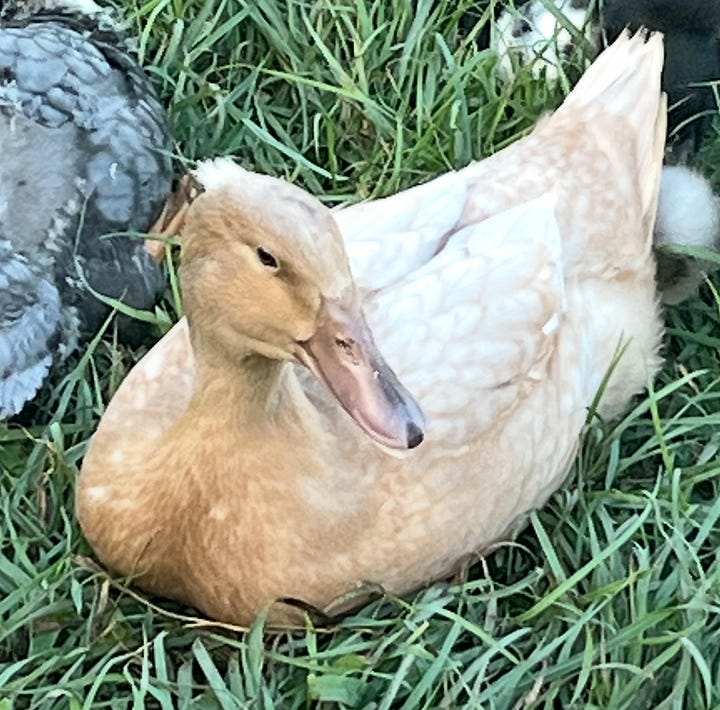
Paris & Gunner with their female mallard coloring
As far as color results from the Crested breeding, it’s still a work in progress. Genetically, White ducks have to be homozygous (two White genes) to be visually White. Breeding White to White produces only White. Frustratingly, though, White ducks are not truly white colored, since they can ‘be’ any color and the double white covers up their underlying color. When I calculated the color results from these hatches using the drake colors possible, it gave me Black Bibbed (Black Swedish) for Cayuga Getafe + White Crested and sex-linked ducklings for my Standard Buff drakes + White Crested. These were Mallard (Gray) males, Blue Mallard (Blue Fawn) males, Buff Lilac Mallard females or Buff Chocolate Mallard females. I tried to distinguish between these last two at hatch which is virtually impossible. The females hatch in yellow tones, some with eyestripes much like my Buffs which have no relevance on sex or future color. So I grouped all yellow babies from this breeding into ‘Buff mallard female’ category regardless of crest. I dna tested four exemplars, one from each color, to check the sex link and if I had been correct about color assessment at hatch. Mallard and Blue ducklings at hatch were male and the two yellow ducklings were female. I probably should have tested Wrexham, but didn’t want to spend the money on it and the results likely would have confused me. As Wrex develops, he is getting body feathers the color and pattern of Mallard male Borussia despite being much lighter and silvery at hatch which made me think female.
One of the June females has also developed away from Paris, Gunner and her two sisters from her same hatch. I go back and forth on if she’s a Lilac Bibbed or actually a Splash color. I named her Chanel because she truly is lovely, unique and fancy. Is she actually the Buff Lilac mallard vs her sisters the Buff Chocolate?
I had to restudy White genes and consider that perhaps because of that, the color calculator is not fully accurate. I’m carefully observing and documenting growth and feather color of the ‘Blue Mallard’ males I hatched, regardless of crest. For now, as juveniles and ducklings, they look more like Blue Bibbed (Blue Swedish) than Blue Mallard or Blue Fawn, its name in Call duck colors.
Show time! I bit the bullet and signed up some of my birds for an open poultry show. This time I will be showing three drakes:
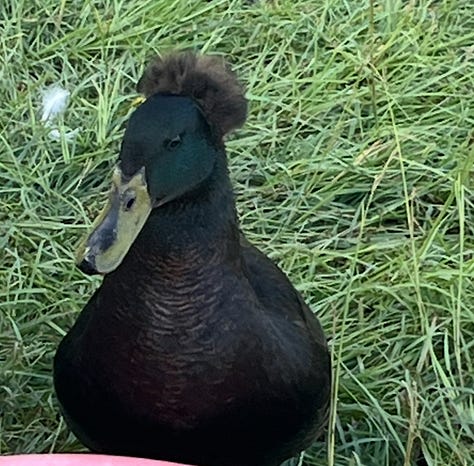
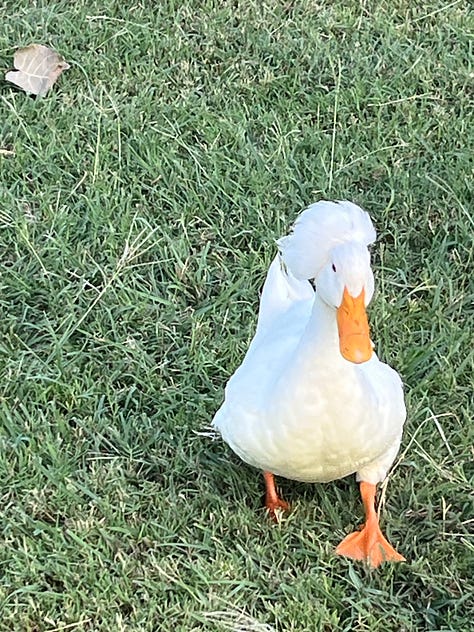
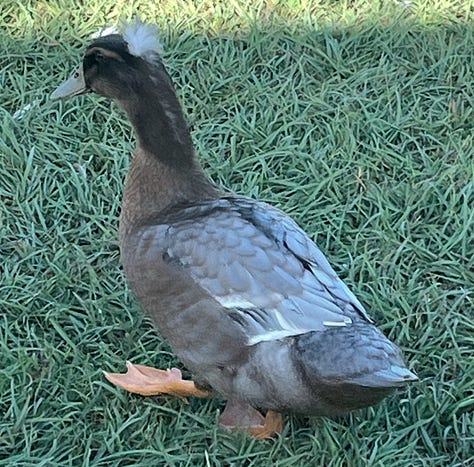
I spoke with an organizer and she said that even though Borussia does not fit the APA standard for either White or Black, I could put him in the show just for exhibition purposes without expecting him to win anything. This is my goal, to get judges to look at my birds as well as visitors to the show. None of my other birds fit the bill (haha) to be shown yet, either because of age (my more interesting colored crested ducklings aren’t fully feathered for another few weeks) or issues with the standard (my Crested ladies have developed speckling on their feet and bills that wouldn’t conform). Perhaps in a few months - the Stock Show is coming up and has a much larger audience than this show.
A big reason for this effort is to encourage more people to dream and perfect ‘breeds’ of ducks. We shouldn’t be limited to the development done decades or centuries ago by breeders or what a dusty piece of paper limits a showable duck to. Breeds and standards were created when the rare became standardized and we should definitely keep dreaming and creating with all of the resources we have at our disposal. My dream of a Crested Blue Mallard duck that was medium sized, dual purpose and great for backyard flocks is one step closer! What is your dream??



